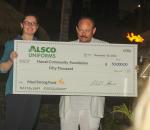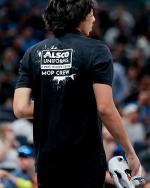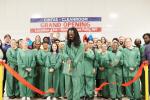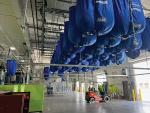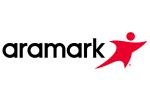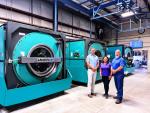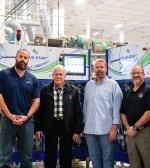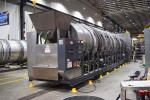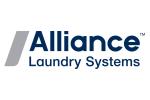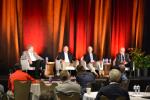CHICAGO — Hiring new employees has been difficult for the laundry and linen services industry for some time.
Even before the events of the past few years, operators were struggling to onboard key personnel such as plant employees, engineers and management.
“Like many industries, hiring remains a challenge,” says Jeff Peterson, sales manager at Spin Linen in Omaha, Nebraska. “We’ve had to re-evaluate everything from compensation to job duties, as well as get more innovative in our job postings to attempt to stand out.
“There doesn’t appear to be a magic bullet, so we are experimenting and tweaking our approach constantly.”
Fortunately, hiring in the industry is improving.
“There seems to be a positive shift lately,” shares Frank Maresca Jr., vice president of WW Uniforms in Wallingford, Connecticut. “The traction for getting new potential employees is increasing.
“The past has been an absolute struggle—from striking interest and applying to the open job to an employee accepting an interview or the position and the person doesn’t show up at all.
“Nevertheless, in recent months there has been an increase in applications and acceptance of the said available jobs.”
“We have started to see our labor pool open up a bit over the last couple quarters,” agrees Ben Warnecke, a fourth-generation family member and general manager at Plymate Inc. in Shelbyville, Indiana.
“Incenting and promoting our employee referral program has resulted in quite a few great hires for Plymate in recent years. We are laser-focused on onboarding and employee engagement once we make a hire, so, thankfully, we don’t find ourselves with more than a couple openings very often.”
Kleen Kraft Services in Commerce, California, has also had success with employee referrals onboarding qualified, dedicated workers.
“In general, we have very little turnover,” says Marilyn McCarty, marketing manager. “Many of our staff have been here for over 10 years and some as long as 40 years. I think this speaks to the type of operation that we run, the pay and benefits offered, and the feeling of belonging.
“Most of our new hires come in as referrals from current employees—drivers, sales reps, office staff—have all come in as referrals. With referrals like this, we can anticipate that the worker will be qualified and that they have a good idea of the work expected.”
While there are signs of improvement in the laundry labor market, many laundry operators still face difficulties.
“Hiring new employees remains a challenge for Paris,” says David Stern, president and CEO, Paris Companies in DuBois, Pennsylvania. “We are getting enough applications for most hires; however, the quality of the applicants has deteriorated from pre-pandemic.”
A major challenge is enticing younger employees to enter the laundry and linen services industry. Many don’t see it as a viable career option and aren’t prepared for the effort needed to succeed.
And some aren’t even aware that the laundry industry exists.
So, how can a laundry operator attract the next generation of laundry employees?
HUMAN RESOURCES PERSPECTIVE
For the textile services industry to get the attention of younger employees, it needs to better understand who the next generation is and what it is looking for in terms of employment and career opportunities.
Elissa Jessup, HR knowledge advisor for the Society for Human Resource Management (SHRM), shares that the organization has researched what younger workers are looking for in a workplace.
For Generation Z (born between 1997-2012), SHRM has compiled a “top 10” list of work qualities they are seeking.
“They’re looking for flexibility, peer coaching, teamwork, diversity, work-life balance, development, growth, social awareness, mentorships and job rotation,” Jessup says.
She says younger millennials (born between 1981-1996) are looking more for performance-based compensation, flexible schedules and a flexible location—whether that’s remote or maybe a hybrid-type situation flexibility.
“Also being able to have marketable skills, so training,” Jessup continues. “Having access to decision makers regardless of what type of level or position they may be in. They want to be able to build those relationships with management and higher leaders in an organization.
“They also want to have a clear area of responsibilities in their job and then a chance to be creative as possible
“And there was something that I thought was interesting, its Gallup survey data, but there were three things that the young millennials and Gen Z both agreed on what they wanted: an organization that cares about their well-being, organizations and leadership that is ethical, and an organization that is diverse and inclusive of all people.
“And the last one wasn’t just an employer having a program saying that they value diversity, but they can actually see those results—you can see the difference in those organizations that do that.”
From Jessup’s experience and studies about the younger generations and how they work, she has found that they want their position to matter. They want it to be part of something bigger than themselves.
“So, if an employer can relate their job to a bigger emphasis and being a part of something bigger than themselves, they want to do that,” she points out. “As opposed to the older generation, where they stayed with the same employer most of their career and were mostly looking at financial stability, things like that.
“The younger generation is a bit more different in that they want to feel passionate about what they’re doing. If an employer can connect what they’re doing and they can feel passionate about that, I think that would make a big difference in what they’re doing.”
This also means that younger employees will likely not remain with an employer for their entire career.
“I believe the data on the younger generation is three to five years with the same employer versus the older generation, which is obviously a lot longer than that with an employer,” Jessup says.
“It is looking that way with our research and especially given how many employers don’t have pension plans anymore. Employees can take their 401k and move that anywhere. They see the value in not only promotion opportunities elsewhere but raising their salary elsewhere.
“There’s not so much that commitment to one organization.”
That’s not to say that all young employees are going to stay with an employer for three to five years, but Jessup suggests that employers need to consider building career paths for younger workers.
“If they can see where their career path is going with a certain organization, they may be more likely to stay with that employer longer,” she points out.
“If an employer creates mentorship opportunities, connecting with someone who is in the direct career field they want to be in, or if there is a different career field within the same organization where they can learn from, having those robust types of training and or leadership programs can often help combat that shorter-term commitment from the younger employees in the laundry operation.”
When it comes to attracting younger employees to either management-level positions or plant operations, Jessup says it depends on the education level of the workers.
“This is more anecdotal, but someone with a college degree isn’t going to want to work in a plant but it can help an employer in general, I would say, to target high school career fairs or maybe even community colleges if maybe they aren’t sure if the four-year degree is for them,” she says.
“Kind of target the right job based off the education level that an employer is looking at.”
But still, even in a plant setting, younger workers will be looking at advancement, being more a part of the team and understanding the whole of what’s going on.
“I think another thing to consider is focusing on well-being,” Jessup shares. “Whether that’s providing an employee resource or just the overall well-being of employees, they want to feel like their organization cares for them.
“I think also having a healthy work-life balance is important. That can be challenging, depending on the type of industry, of course, but integrating work and life and being able to manage that is important to the younger employees as well.”
Ultimately, she says it’s vital for younger workers to have managers who not only provide feedback but also inform them of what’s going on within the organization.
“We have some data for employees, and 61% of millennial workers are engaged when their manager, or supervisor, informs them of what’s going on in their organization,” says Jessup.
“Just keeping employees in the loop, and, again, connecting how their role impacts the organization overall, can help with that engagement.”
The initial challenge, though, is attracting the attention of the younger generations to consider employment in the laundry and linen services industry.
Jessup says employers need to update their recruiting methods for younger workers.
“One idea in recruiting methods is updating the technology,” she says. “Text alerts for job openings. Creating videos for a day in the life of working for either a specific job or a specific company to give an idea of what it’s actually like to work there.
“Make sure the job advertisements are interesting. That they grab the reader’s attention. More likely than not, if the younger applicant is reading something and it’s not engaging right away, they’ll probably move on.
Jessup says that many online job descriptions use a lot of copy-and-paste from job descriptions on file.
“The key point to keep in mind is that a job ad should not just be a copy-paste job description,” she says. “People lose interest very quickly.
“What you could do is the first paragraph, try to make it more interesting in terms of describing maybe the team environment or what they would be doing. Asking questions like, do you want to be part of an innovative team working on X, Y or Z; do one, two or three; do these things appeal to you?
“Thinking outside of the box of how you can engage a reader in seeing this isn’t just any job ad. They’re trying to describe what this position is doing.”
Finally, Jessup says it’s important to streamline the overall recruitment process to reach younger employees.
“Younger workers are more likely to apply to a job with their phone versus a desktop like older generations,” she says. “So, it’s important to make the process easy, efficient.
“Specifically, no one wants to upload their resume and then have to fill out the exact same information on an application. That’s probably the biggest complaint that I’ve heard.
“That’s an area that I think employers could benefit from in at least the recruitment-type process.”
Read Part 2 with views from laundry operators next Tuesday.
Have a question or comment? E-mail our editor Matt Poe at [email protected].



















